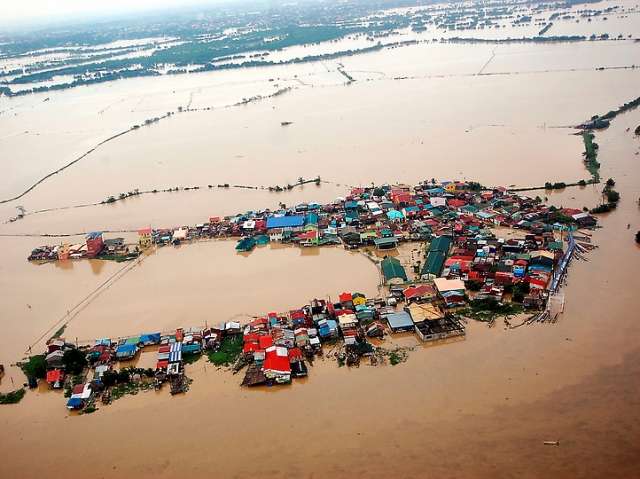by Walden Bello
This July was the hottest July in the United States ever since they started keeping records. In India, the monsoon rains are long delayed, resulting in the country’s second drought in four years. Triple digit temperatures in New Delhi and other cities have already provoked the worst power outages in the country’s history and the expected bad harvest is likely to slice at least five per cent from GDP growth. In Beijing, which usually suffers from a shortage of water, a storm on July 21 resulted in the worst flooding since records began to be kept in 1951, according to the Economist. Meantime, here in the Philippines, the protracted “rainstorm with no name” (as PDI columnist Jose Montelibano christened it) that persisted for over a week plunged Metro Manila into a watery disaster that is now said to be worse than Ondoy.
The ‘new normal’
It’s climate change, and Department of the Environment and Natural Resources head Ramon Paje captured the nature of nature’s wrath when he said that the “new normal” in our climate is unpredictable weather owing to the uncontrolled rise in the globe’s mean temperature due to greenhouse gas (GHG) emissions. If there is any doubt that the abnormal is now the norm, remember that this is shaping up to be the second straight year that non-stop rains have wreaked havoc in Southeast Asia. Last year, the monsoon season brought about the worst flooding in Thailand’s history, with waters rushing down from the north of the country engulfing even Bangkok, affecting over 14 million people, damaging nearly 7000 square miles of agricultural land, disrupting global supply chains of transnationals with subsidiaries in the country, and bringing about what the World Bank estimated to be the world’s fourth costliest disaster ever.
Perhaps the most frustrating thing about the unceasing rainstorms is we could do little to prevent it. We could have made it less calamitous by resettling informal settlers away from the floodways to Manila Bay and reforesting the hills and mountains that border the Metropolitan area. We could have passed the Reproductive Health Bill much earlier and propagated family planning to reduce the human impact on the upland, rural, and urban environments. We could have, in short, taken measures to adapt to changing climate patterns. But to prevent the fundamental shifts in regional and global climate was something we could not do
The non-committal north
Climate change is triggered by the accumulation of carbon dioxide and other greenhouse gases in the atmosphere. 66 per cent of the greenhouse gases that have accumulated in the atmosphere from 1890 to 2007, according to Wikipedia, have been contributed by the developed countries, meaning the United States, the European Union, Japan, and Russia. Yet these countries are also the most difficult to persuade to take action to deal serious with global warming by curbing their emissions, limiting consumption, and providing aid to developing countries to deal with climate change.
The US Congress is populated by Republican climate skeptics who continue to believe, against all evidence, that climate change is a figment of the liberal imagination and have prevented the passage of what is already a weak climate bill. The European Union has committed to curbing greenhouse gas emissions, but this is to be accomplished largely through weak or unrealistic containment measures like carbon trading or technofixes like carbon sequestration and storage, not by moderating economic growth or reducing consumption, which remains the principal engine of greenhouse gas emissions. Currently, with their economies stalled and desperately needing to get restarted owing to the financial crisis, curbing greenhouse gas emissions has very low priority in the agenda of European leaders.
Stop hiding behind the developing countries
The North-South dimension has added a deadly dynamic to this process, as the so-called emerging capitalist economies of the South, notably China and India, make their claims to their share of ecological space to grow even as the capitalist economies of the North continue to refuse to give up any of the vast ecological space they now occupy and exploit. China is now the world’s biggest contributor of greenhouse gases, but the basis of its refusal to entertain mandatory limits to its greenhouse gas emissions is that its accumulated emissions have, historically, been quite low, standing at some 9 per cent of the historical total.
The refusal of the North to curb high consumption and the effort by the big emerging economies to reproduce the Northern consumption model lies at the root of the deadlock in the climate change negotiations—one symbolized by the failure of the United Nations-sponsored talks in Copenhagen in 2009 and Durban in 2011 to agree on the contours of a successor agreement to the Kyoto Protocol.
What was agreed upon in Durban was that governments would submit their offers for GHG reductions by 2015, but these would be implemented only in 2020. But by then, it will already be too late, say many experts, since countries will already be locked into a high carbon development path. Scientist say that given the absence of mandatory emissions limits in the next few years, the world is on track to pass the 2 degree Celsius gain to which they would like to confine the rise in global mean temperature, and is already on a trajectory of a 4 to 5 degree temperature rise, which would be nothing short of calamitous in its consequences. Reflecting what many see as the maddeningly nonchalant attitude of Washington, Todd Stern, a US climate official, recently urged governments to give up the 2 degrees rise target and sought a “more flexible” international agreement based on voluntary targets. This can only provide the governments of countries on a high growth path an excuse to postpone making commitments, if not junk mandatory reductions altogether.
When diplomacy fails
The countries that are most threatened by climate change, like the Philippines, must do all they can to break the deadlock. To stress the urgency of arriving at a serious global agreement soon, the governments of these countries can engage in what might be called “anti-diplomacy.
For instance, President Aquino can call Ambassador Harry Thomas to the Palace, like he would the envoy of the country with whom the Philippines has a national security dispute, and return the check for the $100,000 that the US recently contributed to the government’s relief efforts in Metro Manila. He can tell Ambassador Thomas that what the Philippines really wants is for the US to immediately agree to deep mandatory cuts in carbon emissions, to be implemented in 2013, instead of 2020. He should also advise Thomas that instead of making paltry disaster relief contributions, the US should immediately commit to give $25 billion to the $100 billion Green Climate Fund that developed countries agreed to set up during the 2011 Durban Conference but have yet to fund.
The administration should also lead in bringing about a coalition of threatened countries outside the framework of the Group of 77 and China. The problem with the Group of 77 and China coalition is that it is an artificial coalition that brings together the so-called emerging markets that are mainly committed to high-speed industrial growth like China, India, and Brazil, with countries whose key interest is to prevent global disasters brought about by unrestricted carbon-intensive economic growth. This parallel grouping should demand that Brazil, China, and India stop hiding behind the rubric of being “developing countries” and agree to mandatory limits to their greenhouse gas emissions as soon as possible.
Some of the elements for such a developing country coalition that would push an agenda separate from the Group of 77 and China and the North are already present. These are the Africa Group, the Alliance of Small Island Countries, and the Least Developed Countries. According to the Overseas Development Institute, “AOSIS and Least Developed Countries (LDCs) are calling for 45% reductions on 1990 levels by 2020 and 85% by 2050. The African Group has called for developing countries to reduce their overall carbon emissions by at least 95% below 1990 levels by 2050. This shall be achieved during subsequent commitment periods by the end of 2050.” The emergence of a broader coalition incorporating these groupings that the Philippines would be part of would serve as an important notice to both the North and the big emerging markets that they better get down to the business of negotiating mandatory cuts soon.
To show the US, EU, and China, we mean business, although the Philippines is not a major GHG emitter, the administration must commit to reduce the country’s greenhouse gas emissions by some 20 per cent by from its levels in the 1990’s by 2020. This will mean, among other things, shelving Energy Secretary Rene Almendras’ disastrous plan to set up a national network of coal-generated power plants, which are probably the worst energy generation plants from the perspective of GHG emissions. We can’t be seen demanding cuts while increasing our own emissions.
That climate has become our No. 1 national security issue is something the events of the last week have made very clear. When diplomacy fails, we have no choice but to resort to strategies like anti-diplomacy to safeguard our national security and national interest. Our weapons are few, and often they are only mechanisms of moral suasion, but we must use them and hope for the best.
*This article was first published in the Philippine Daily Inquirer.










